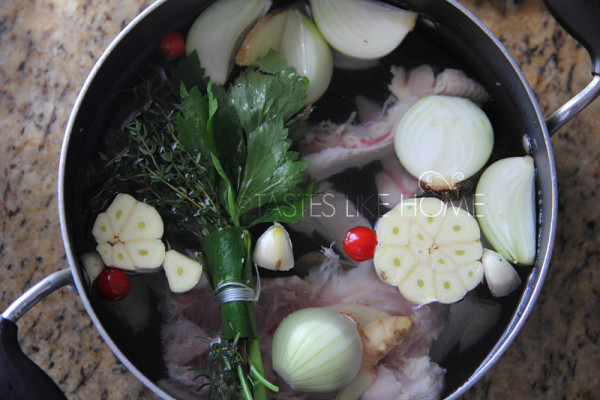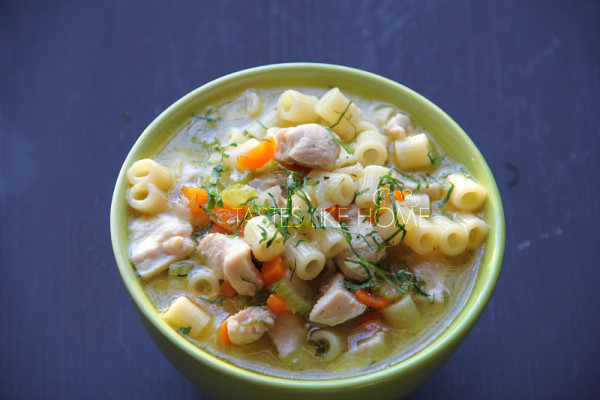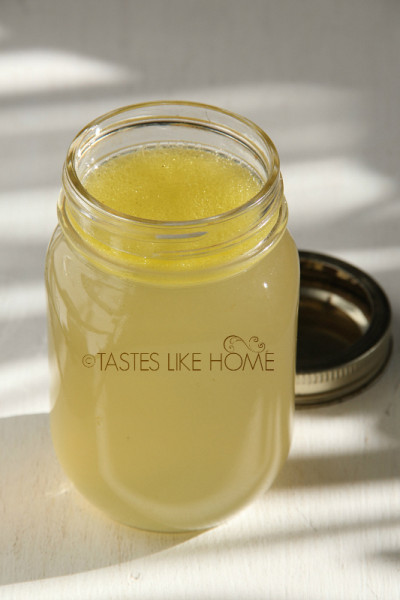Hi Everyone,
You can enrich your meals, reduce salt, and save money by making and using your own homemade stock.
Stock is a flavoured cooking liquid made from meat, bones, seafood, vegetables, herbs and spices cooked in water for a period of time to extract the flavour from the ingredients used. The extraction of iron, collagen and vitamins from bones and marrow not only provides excellent flavour and body to a stock but it is also good for you. Do you notice how we gravitate to soups when we are sick, especially chicken soup, (which many people refer to as liquid penicillin)? There is something about the low, slow, gentle cooking of the ingredients in a large pot of water that unlocks flavours and nutrients that nourish and satisfy.
 While there are many uses for stock – soups, stews, sauces, casseroles, stuffing and pilaf-type dishes – there are also different approaches to making stock. Stock can be made from various types of meats, bones, seafood, and vegetables. It is generally made with scraps and bones that have been butchered for other purposes. For example, when I buy whole chickens and cut them up into various pieces – thighs, drumsticks, wings, breast, and backbone – I always reserve a certain amount of the pieces to make stock. When I butterfly a chicken to roast, I save the centre cut of the backbone for stock. If the chicken is cut into large pieces for baking, I’d save the entire back and the tips of the wings to make stock. Or, if I de-bone the breast, the bones are saved for stock making. When I buy bone-in beef, pork or lamb, depending on how I plan to cook them, I would have the butcher remove part or all of the bone along with any connective tissue, skin and cartilage, which I would use to make stock. At the fish market, again, depending on what I to plan make with the fish, once the fillets are removed, I’d have the fish guy bag the middle bone and fish head to make stock. Similarly, when I buy prawns, I save the shells to make stock. When I am doing a refrigerator clean out, I assemble the vegetables to make stock.
While there are many uses for stock – soups, stews, sauces, casseroles, stuffing and pilaf-type dishes – there are also different approaches to making stock. Stock can be made from various types of meats, bones, seafood, and vegetables. It is generally made with scraps and bones that have been butchered for other purposes. For example, when I buy whole chickens and cut them up into various pieces – thighs, drumsticks, wings, breast, and backbone – I always reserve a certain amount of the pieces to make stock. When I butterfly a chicken to roast, I save the centre cut of the backbone for stock. If the chicken is cut into large pieces for baking, I’d save the entire back and the tips of the wings to make stock. Or, if I de-bone the breast, the bones are saved for stock making. When I buy bone-in beef, pork or lamb, depending on how I plan to cook them, I would have the butcher remove part or all of the bone along with any connective tissue, skin and cartilage, which I would use to make stock. At the fish market, again, depending on what I to plan make with the fish, once the fillets are removed, I’d have the fish guy bag the middle bone and fish head to make stock. Similarly, when I buy prawns, I save the shells to make stock. When I am doing a refrigerator clean out, I assemble the vegetables to make stock.
Stocks can also be made with cooked meats and bones. The carcass of a roast chicken can be further cooked to make stock. The bone(s) of your roast can be added to a pot to make stock (think ham bone). There is, however, a difference in the taste of stock made with fresh ingredients as opposed to stock made with cooked ingredients. Stock made with fresh ingredients has a superior taste.
On its own the main ingredients for a stock give good base flavour but the addition of herbs and spices enhance and elevate the overall flavour of stock. Onions, celery, parsley and carrots are the standard herbs for stock; however, I always add fresh thyme, garlic, and bay leaf to my stock. Other ingredients such as fresh root ginger, tarragon, rosemary, oregano or marjoram as well as spices like star anise, whole cloves, allspice, cinnamon and coriander seeds can be added to stock. One thing to bear in mind is that the latter list of ingredients has assertive flavours and should only be added if the stock is to be used to make dishes in which the flavours would be complementary.
Cooking Stock
There is no right or wrong way to make stock; it is a matter of preference and the flavour profile you seek. The one ‘rule’ I believe is to cook the ingredients at a simmer for a long enough period of time to facilitate the release all its nutrients and flavour.
The generally accepted ratio of meat/bones to water is 1:2 (1 part meat/bones and 2 parts water). In this case for every pound of ingredients, add 2 quarts (8 cups/4 pints) water.
Use the following as a guide if you are making stock with 2 pounds of meat/bones stock:
- 1 large onion
- 2 carrots
- 3 large stems (Chinese/Guyanese) of celery (leaves
and stalks)
- 4 stems of parsley (leaves and stalks)
- 1 bay leaf
- 3 long sprigs thyme
Some recipes suggest, chopping the ingredients into large chunks or adding them whole once peeled while others recommend cutting the peeled ingredients into dice-like pieces. The herbs can be sautéed to soften and get the flavours going but the ingredients can all be added at the same time to be brought to a boil. As I said at the beginning of this section, there is no right or wrong way to make stock. It really is about your preference.
Put the pot over high heat and bring to a boil then reduce the heat to low and let simmer. Froth will form once the pot comes to a boil, skim the surface, and cook for 1 and ½ hours. If you are making fish/seafood stock, only cook for 20 to 25 minutes, for vegetables only cook for 15 – 20 minutes. If you are using all bones or bone-in meat to make stock, they should simmer for the full 90 minutes but if you are using only meat, you can stop the cooking process at the hour mark. It is important that I emphasize here that stock making is about extracting, releasing flavours from ingredients, therefore, cook the stock at a simmer and not a boil. This low, slow cooking is what will yield the depth of flavour being sought and prized.
If you have a pressure cooker, use it, and significantly cut down on the cooking time.
Now here is where you can significantly cut down on the sodium in your food. Many people use stock cubes (bouillon cubes) in their everyday cooking. Those cubes generally have in a lot of salt and then we tend to add more salt to the food (to taste). I am not saying that you should abandon the use of cubes but I am saying that if you make your own homemade stock, you can get a lot of the flavour and richness you seek in your food without a lot of added salt. When making your stock, you can opt not to add any salt at all and only add salt to the dish when cooking. Personally, I do add a little salt to my stock but not enough to taste, just a little to enhance.
Storing Stock
Once your stock is done cooking, let it cool to room temperature and strain through a sieve into jars or containers with accompanying airtight lids. To ensure that your stock is clear of any particles, line the sieve with a couple pieces of paper towel and then strain the stock.
Meat and bone stock usually have fat and it is easy to defat stock. Let the stock cool naturally or put it in the refrigerator where the fat will congeal at the top making it easy to be scooped off. De-fatting your stock is optional.
Stock can be stored in the refrigerator and freezer. When frozen, it lasts for months, however, if storing in the refrigerator, store for a couple of weeks only. However, if you want it to last longer in the refrigerator, remove it after the 2 weeks, bring it to a boil for a few minutes, let it cool completely and refrigerate for another 2 weeks. This re-boiling will concentrate the flavour of the stock and will also reduce in quantity through evaporation as it cooks.
The concentration of flavour brings me to the question of stock versus broth. The difference between the two terms lies in cultural and colloquial terminologies. Stock refers to liquid simmered with ingredients that are removed before use while broth is a soup, a thin-liquid soup that has in solid pieces of meat or fish along with vegetables and starches like pasta, rice or pulses. These added ingredients make a broth more substantial.
Let me reiterate what I said at the beginning: enrich your meals by using your own stock. Reduce your salt intake by controlling the amount of salt added to your homemade stock. Save money by making your own stock instead of buying pricey boxed and canned stock (except if you are in a pinch). The main thing to remember when cooking with stock is to use it as an ingredient, as a building block to whatever dish you are making. It is there to enrich, not dominate.
Cynthia









